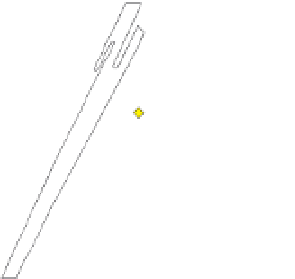Geoscience Reference
In-Depth Information
a)
12
Wt (%)
ppm
ppm
20
K
Th
U
2
6
10
1
0
0
0
0.0
0.5
1.0
0.0
0.5
1.0
0.0
0.5
1.0
Molar K/(K+Na+2Ca)
Molar K/(K+Na+2Ca)
Molar K/(K+Na+2Ca)
Increased alteration
b)
K/Th
Altered
Unaltered
10
5
Increased alteration
Figure 4.20
Geochemical data of altered and unaltered
rocks from the Waitekauri area. (a) Variation in
radiometric element content with hydrothermal
alteration. (b) Variation in K/eTh ratio with silica
content. Redrawn, with permission, from Booden et al.
10
4
10
3
40
50
60
70
80
SiO
2
(%)
aware of these limitations and account for them in the
analysis of the data. More encouragingly, one limitation
of the radiometric response makes it easier to interpret.
Being controlled by materials in the top few tens of centi-
metres, radiometric data are free of the complications of
superimposed responses from greater depths, unlike the
situation for gravity, magnetic and electrical data. Further-
more, the radiometric response has a very simple relation-
ship to its source, again unlike gravity, magnetic and
electrical data, because the transition from background to
anomaly is very abrupt and coincides with the edges of the
source,
a)
Cover
Shaft
0
50
Metres
b)
3.0
facilitating accurate mapping of near-surface
2.0
contacts.
An understanding of the distribution and behaviour of
K, U and Th in the geological environment, and in par-
ticular their occurrence in different lithotypes and the
possibility for their redistribution by secondary geological
processes, is essential for producing a geologically mean-
ingful interpretation of radiometric data. Since the
response originates in the near-surface, the radiometric
properties of the overburden and the effects of sur
cial
geological processes are particularly important. Unfortu-
nately, these are often complex and not well understood,
more than negating the advantages of the favourable
response characteristics in most terrains. A further compli-
cation is that eU and eTh concentrations are derived from
γ
1.0
0.0
Partly
altered
Unaltered
andesitic-basaltic tuff
Intensely
altered
Altered
Veins
Figure 4.21
The Iron King Pb
Ag sulphide deposit.
(a) Geological map of the area around the deposit. The symbols
designate sample locations and degree of alteration. (b) Correlation
between K content and degree of alteration in tuffs. Redrawn,
with permission, from Moxham et al.(
1965
).
-
Zn
-
Cu
-
Au
-
concentrations of potassium (K), uranium (U) and thor-
ium (Th) in the survey area. In practice this is not entirely
achieved because of limitations in the various calibration
and correction procedures, so the interpreter must be
-emissions of daughter
elements;
this
allows
the













































































































































































































































































Search WWH ::

Custom Search